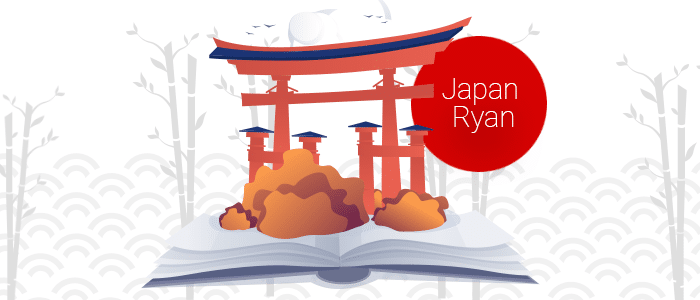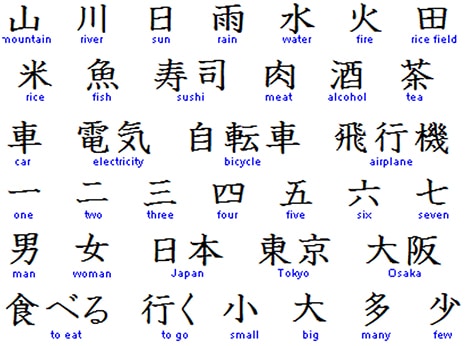
Welcome to my Japanese lessons for absolute beginners. Learning Japanese from scratch may seem daunting, but that’s because it is often presented as a monumental task of memorizing 2000 unique kanji characters along with their meanings. Each kanji can have as many as 10, or even more, different meanings (imi), especially when combined with other kanji to make words.
But we’re not going to begin (hajimete) with all that and try to memorize the kanji, because that is a silly and inefficient way to try to learn Japanese. The best way to learn Japanese is through meaningful, fun interactive contextual learning.

This way you start to grasp the imi (meaning) of words as you read them and integrate them into your mind and memory. Learning Nihongo this was is hayai (fast) and efficient. Hajimete (begin) learning Japanese with this technique and you will pick up the language naturally.
It’s kantan (easy). The imi of each word in context will become familiar in your brain automatically, in a more hayai way then trying to study through rote memorization.
How to learn Japanese from nothing.

You can easily learn Japanese from nothing. It’s not very muzukashi (difficult). You might even find it kantan (easy). I try to make learning Japanese as kantan as possible. It requires dedication, but not the boring, slow-progressing way taught by normal sensei (teachers).
A first thing to note is there are no plural kotoba in Japanese. Both “word” and “words” are going to use the word “kotoba”. Never “kotobas”. To illustrate multiples, you would just put a number before the word. Ni sensei. Two teachers.
That’s not always exactly correct, because Japanese does have something not found in English – counter words. “2 oranges” in English becomes “2-round object- orange” in a literal Japanese translation.
Can you translate Japanese word for word?
No. The above example brings me to this important point. Japanese grammar is often wildly different than English, so translation often includes subtle word additions and changes meant to reflect what the speaker or writer intended to say, rather than simply what she literally wrote.
Take a person saying “Sugoi!”, which literally means “Great!” In context, picture a character in a TV show seeing an impressive sports car and saying sugoi. A better translation for what they intended to say is not “great” but “That’s awesome!” or “Sweet car!” Subjects are often implied and not outrightly expressed in Nihongo.
Is reading Japanese easy?

Japanese kotoba (words) are often easier to read than English words, because pronunciation of hiragana is always the same. Think in English about the words “though, through, and rough” or “Colonel and kernel”. These words illustrate english’s history of borrowing words from other languages, and yet trying to retain some of the pronunciation
When the Japanese borrow words from English or other languages they then pronounce them in a Japanese way. Many words in Japan came from another country, but it’s not always English. For example, the word pan (bread) is Portuguese.
Japanese learning with a book.

I wrote a hon (book) about my travels in Japan, and it also teaches some Japanese language as you’re reading. I devised a unique method for learning languages, and I’m hoping it makes learning very hayai and kantan for you.
There are also several other books I recommend for learning Japanese. One of my favorites is the “Making Out in Japanese” series because it’s silly and contains actually useful phrases to use in everyday life like ordering at a restaurant.
Lesson 1 – Absolute beginners.
Okay, let’s start with your first grammar lesson. I will teach you how to use possessive particles. Many other lessons start elsewhere, but I think this is a better place to start.
The particle no indicates possessiveness, or a sort of “belonging to” hierarchy. The hiragana for this looks a little but like the at symbol.
| Ryan no hon. | Ryan’s book |
| Keisha no jugyoin. | The company’s employees. |
The use of the particle can sometimes be stretched a little as long as you’re indicating belonging.
Hidari no hidari.
Left’s left or more explicitly “the leftmost left”. This kind of usage is not always common, but it can be a last resort way to connect items in a hurry.
Now let’s start describing things! We will use the particle wa and the verb desu.
Ryan no hon wa akai desu.
Ryan’s book is red.
Verbs usually go at the end in Japanese. That’s different than English which usually features the verb in the middle or the beginning. English uses S-V-O while Japanese is more S-O-V.
This can make Japanese sentences impossible to predict or understand until the very end of the sentence, meaning you may have to listen more carefully than you’re used to. Take this example.
I lost my big red bouncing ball.
My big red bouncing ball is a thing I lost.
In the second example sentence we have no idea what happened to the ball until the sentence is over. The ball could be expensive, it could grant wishes, it could have popped, we don’t know until the sentence is over.
Possessive and definitive.
Particles learned so far:
no = possessiveness.
wa = subject marker.
These two are possibly the easiest to understand of all the particles in Japanese. You can form quite a lot of meaningful phrases by simply knowing nouns and these particles.
Verbs learned so far:
desu = to be or “is”.
Hon wa akai desu.
Literal: The book (subject) red (to be/is).
Actual: The book is red.
Watashi no hon wa akai desu.
Literal: I (possessive) book (subject) red (to be/is).
Actual: My book is red.
You can build a lot just from that!